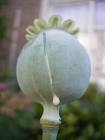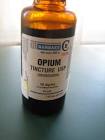Turn your phone side ways for best viewing!

The History Of Opium

Ethnobotanical History of The Opium Poppy




Ezekiel 47:12 "And by the river upon the bank thereof, on this side and on that side, shall grow all trees for meat, whose leaf shall not fade, neither shall the fruit thereof be consumed: it shall bring forth new fruit according to his months, because their waters they issued out of the sanctuary: and the fruit thereof shall be for meat, and the leaf thereof for medicine."
Nicknames: Opium; Joy Plant[1] Pen Yan[1] Paregoric[1]
Introduction: "Opium is a highly addictive narcotic drug obtained from the juice (latex) of the unripe seedpod of the poppy plant (Papaver somniferum). The traditional practices of latex processing vary from place to place and may include air-drying, heat-drying, or boiling."[5] "Chemically, opium is a complex mixture; notably, it contains several alkaloids, including morphine, codeine, noscapine, thebaine, and papaverine."[5] I will discuss some details on the pharmacology of noscapine, thebaine, and papaverine in another paragraph below. "The alkaloid components of opium or their derivatives are responsible for its analgesic, hypnotic, antitussive, and antidiarrhoeal effects when consumed."[5] I want to point out that these substances are some of the most miraculous medicines on the planet, despite the fact that they're viewed negatively by anti-drug lunatics. We owe the creator gratitude, but our modern culture and its socialist influence have the massses brainwashed to view pharmaceuticals as morally acceptable and plant-based ethnobotanical narcotics to be somehow unrighteous simply because they're not made in a lab, or "FDA" approved.
"It took millennia for opium to reach North America, where colonists eased ailments with laudanum, a bitter elixir of alcohol and opium. In the 19th century, recreational smokers sought opium for euphoria and relaxation, while parents soothed restless and teething babies with opiate-laced syrups. Women sipped opium tinctures for everything from menstrual cramps to anxiety."[6] Here is a very interesting fact indeed: "Seeking a more controlled medical formulation, a young German pharmacist's apprentice named Friedrich Wilhelm Adam Sertürner isolated one of opium’s active ingredients in the early 1800s. He named the new compound after Morpheus, the Greek god of dreams."[6] O.G. Observation: I've often shared an observation that I've observed with others, and that observation.. is that Morphine is an oneirogen(a drug that stimulates dreams and their vividness and ease of memory). That makes this fact about it being named after Morpheus, the Greek god of dreams very fascinating to me. I really like learning more applications of drugs that are not common knowledge, because they're very versatile and complex creations.

"In the early 18th century, Americans relied heavily on imported English medicines and remedies. The term 'patent medicine' itself originated from English patent medicines, whose ingredients were granted royal protection and exclusivity. However, following the Revolutionary War, a growing preference for American-made products led to the emergence of a new market for homegrown patent medicines. This shift marked the birth of the modern medical market in America."[6] What I just quoted is important because I want to emphasize the point that the prohibition of these sacred narcotic ethnobotanical medicines is all about this greedy desire to grant royal protection and exclusivity for the production and sale of certain drugs that are derived from these ethnobotanicals(ie: pharmaceuticals). This is why Opium was banned, so that the socialist could push fentanyl. In the early 1900's, the socialist in the U.S. began their attempts at eradicating certain ethnobotanical narcotics, like Cocaine, Opium, and Marijuana.[x][x][x] "By 1912, thousands of people were dying on an annual basis from cocaine abuse, prompting the United States to ban the drug in 1914."[7] "As early as 1925, the U.S. government advocated the destruction of crops used in drug production, including coca, opium poppy, and cannabis."[8] That last quote is in reference to operations to destroy crops specifically, not the first attempts at prohibitions. According to the Department Of Justice: "The first law, enacted February 9, 1909, prohibits the importation and use of opium for other than medicinal purposes. This was followed by an amended version in 1914. Another law enacted at the same time regulates the manufacture and smoking of opium within the United States."[9] There are so many "acts" and "drug laws" that it seems confusing when you research this topic. It leaves people wondering why the conflicting information, but it's not that the information is conflicting, it's that the government has imposed an insane number of laws related to drugs, and they only evolve and pile on top of one another as time ticks on. An example is the 1906 Pure Food and Drug Act required that drugs list active ingredients such as opiates, which was only 3 yers before the prohibition of the importation of opium.[6] Then there was the Marihuana Tax Act of 1937 and many more drug laws prior to that, and tons after.[10]
"The Controlled Substances Act of 1970 tidied up by sorting selected psychoactive drugs into five classes based on accepted medical use, potential for addiction, and harmfulness. Once again, the country grappled with the competing desires to provide legitimate medications to patients while protecting the public from their dangers."[6]
Important Related Educational Blogs: Exposing The Occult Socialist Plot Against The Original Ethnobotanical Industry And Why It Matters.,Exposing the '2c series' of research chemicals as fake mescaline and fake amphetamines.,Whats the difference between natural DMT and research chemical DMT?,Quiz One On DMT,Natural Amphetamines Vs Research Chemical Amphetamines,,Whats the difference between research chemicals and phytochemicals?,Medical(Pharmacology Glossary),,Quiz One On Mind Body Systems,Quiz 1 on: Marijuana Prohibition & Socialist Propaganda During 1900's
Buy





Academic citations:
[5] IARC Working Group on the Identification of Carcinogenic Hazards to Humans. Opium Consumption. Lyon (FR): International Agency for Research on Cancer; 2021. (IARC Monographs on the Identification of Carcinogenic Hazards to Humans, No. 126.) 1., Exposure Characterization. Available from: https://www.ncbi.nlm.nih.gov/books/NBK586388/
[6] John Hopkins University: https://magazine.publichealth.jhu.edu/2023/brief-history-opioids-us
[7] https://pmc.ncbi.nlm.nih.gov/articles/PMC6197930/ DARK Classics in Chemical Neuroscience: Cocaine | PMCID: PMC6197930 NIHMSID: NIHMS971587 PMID: 29630337
[8] https://ciaotest.cc.columbia.edu/pbei/fpif/cop02/cop02.html
[9] Department Of Justice: https://www.ojp.gov/ncjrs/virtual-library/abstracts/opium-and-narcotic-laws
[10] https://law.stanford.edu/2014/12/19/the-drug-war-at-100/
[2] Balick, Michael J., and Paul Alan Cox. Plants, people, and culture: the science of ethnobotany. Garland Science, 2020.
[3] Tyler, Varro E, et al. Pharmacognosy 1988 (9th Edition)
[4] Swerdlow, Joel L. Nature's Medicine : Plants That Heal. Washington, D.C., National Geographic Society, 2000.
Encyclopedia Sources:
[1] Erowid: https://www.erowid.org/chemicals/opium/opium.shtml
Other resources:
M.A.P.S. Ethnobotanical Studies By Scholars
National Library Of Medicine https://www.nlm.nih.gov/
PubChem - pubchem.ncbi.nlm.nih.gov
